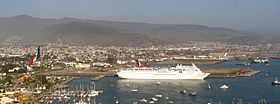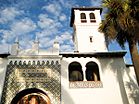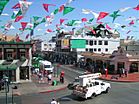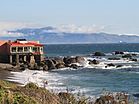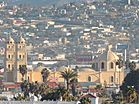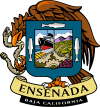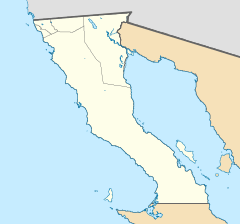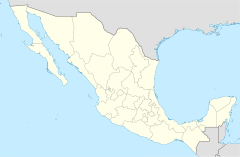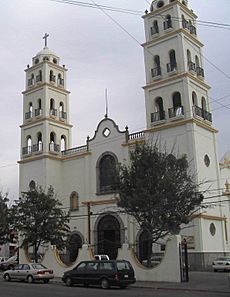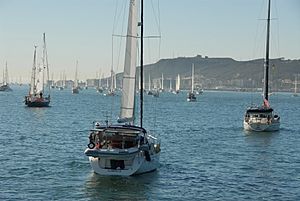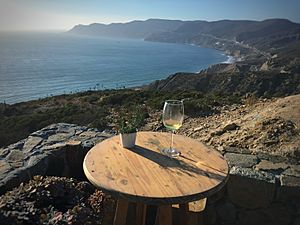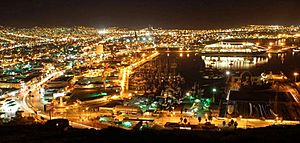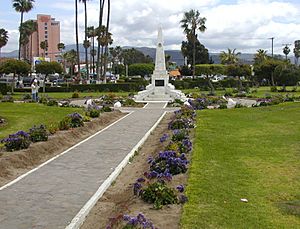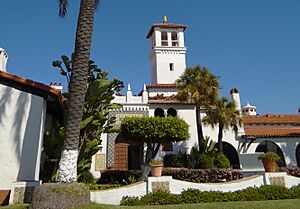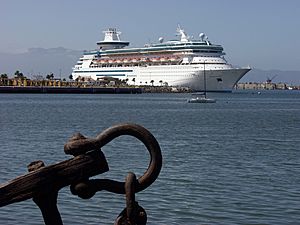Ensenada, Baja California facts for kids
Quick facts for kids
Ensenada, Baja California
|
|||
|---|---|---|---|
|
City and municipality
|
|||
|
Top: view of Ensenada from the Pacific; middle: Riviera del Pacífico Cultural Center (left), Downtown Ensenada (right); bottom: Ensenada’s Pacific Coast (left) and Cathedral of Our Lady of Guadalupe (right).
|
|||
|
|||
| Nicknames:
Cenicienta del Pacífico
(Cinderella of the Pacific) |
|||
| Country | |||
| State | |||
| Municipality | Ensenada | ||
| Founded | May 15, 1882 (by Porfirio Díaz) | ||
| Government | |||
| • Type | Ayuntamiento | ||
| Area | |||
| • Municipality | 19,878 km2 (7,675 sq mi) | ||
| • City | 79.17 km2 (30.57 sq mi) | ||
| Elevation | 16 m (52 ft) | ||
| Population
(2020 census)
|
|||
| • Municipality | 443,807 | ||
| • Density | 22.3265/km2 (57.8255/sq mi) | ||
| • City | 330,652 | ||
| • City density | 4,176.48/km2 (10,817.0/sq mi) | ||
| Demonym(s) | Ensenadan (English), ensenadense (Spanish) | ||
| Time zone | UTC−8 (PST) | ||
| • Summer (DST) | UTC−7 (PDT) | ||
| Postal codes |
22800–22899
|
||
| Area code(s) | 646 | ||
Ensenada means "inlet" or "bay." It is a lively city in Baja California, Mexico. You can find it on the Pacific Coast of Mexico. The city sits right on Bahía de Todos Santos, a beautiful bay. In 2018, about 279,765 people lived there. This makes Ensenada the third-largest city in Baja California.
Ensenada is a big center for international trade. It is home to the Port of Ensenada, which is one of the busiest ports in Mexico. Many people visit Ensenada because of its warm weather and ocean views. It is often called La Cenicienta del Pacífico, which means "The Cinderella of the Pacific."
The city was founded in 1882. It started as a small community called Rancho Ensenada de Santos. It quickly became the main city for the northern part of the Baja California Territory. Ensenada grew a lot when mines opened in the nearby mountains. Later, during the Mexican Revolution, the city's growth slowed down.
However, when Prohibition in the United States began, Ensenada became a popular place for Americans. They came looking for fun and entertainment. By the 1950s and 1960s, Ensenada was known as a great resort town. Many new buildings were built, and the city became famous outside of North America.
Today, Ensenada is a key place for business and culture in Baja California. It has many universities, like the Ensenada Institute of Technology. It is also a major center for biotechnology. This means it has many research places, such as the Ensenada Center for Scientific Research and Higher Education. Ensenada is also part of the UNESCO Creative Cities Network.
Contents
Ensenada's Past: A Journey Through Time
When the first European explorers arrived, the Yuman people lived here. Groups like the Kiliwa, Paipai, and Kumeyaay still live in the area today. These groups were semi-nomadic. They lived in the bay area and the valleys of the Sierra de Juárez and Sierra de San Pedro Mártir.
Early Explorers and New Names
The bay where Ensenada is now was first seen by sea in 1542. The Portuguese explorer Juan Rodríguez Cabrillo sailed here. He named the city San Mateo. In 1602, Sebastián Vizcaíno was mapping the coast. He was looking for safe places for Spanish ships coming from Manila to Acapulco. He renamed the city Ensenada de Todos Santos. The word "Ensenada" means 'bay' or 'cove'.
First Settlements and Changes
The first lasting settlement was started by the Jesuits. This happened in the 1600s or 1700s. After the Jesuits left in 1768, the Dominicans took over. In 1805, José Manuel Ruiz Carillo was allowed to settle in Ensenada. He became the governor of Baja California. He built a house that lasted for many years. It was even briefly taken over by William Walker in 1853-54.
Becoming a Capital City
In 1882, Ensenada became the capital of Baja California. The English Mexican Land and Colonization Company tried to develop the area. But the Mexican Revolution stopped these plans. The area was left in ruins. In 1915, the capital moved to Mexicali. By 1930, only 5,000 people lived in Ensenada. In the early 1900s, the city's name was shortened to Ensenada. This was to avoid confusion with Todos Santos in Baja California Sur.
Growth Through Tourism
Ensenada's growth in the 1900s was helped by a time called Prohibition. During this time, people in the United States and Canada looked for places to have fun. This helped cities like Tijuana, Rosarito, and Ensenada become popular tourist spots. The Hotel Riviera del Pacífico opened in 1930. It became a famous place, visited by important people and artists. Even though it closed in 1964, it later reopened as a cultural center and museum. By the 1950s, Ensenada's population grew to 20,000. Other hotels opened, and the city's economy grew.
In 2007, Pope Benedict XVI created the Diocese of Ensenada. This made the city an important religious center.
Exploring Ensenada's Landscape
City Views and Landmarks
Ensenada is mostly a beach city with medium-sized buildings. The Villa Marina Hotel is the only tall building. However, new resorts like Entremar and La Costa are adding to the city's skyline. You can find many famous spots near the bay. These include the Civic Plaza, also known as the Plaza of the Three Heads. It has sculptures of Mexican heroes. There is also a huge Mexican flag and the Malecon boardwalk. Several marinas are located along the coast, like Ensenada Cruiseport Village. The Bajamar Oceanfront Golf Resort is also nearby. It is a well-known seaside resort in Baja California.
Amazing Animals and Plants
Many animals and plants around Ensenada and the Baja California islands are unique. Guadalupe Island, off the coast, is a great place to see great white sharks. This island has been a wildlife sanctuary since 1975.
The ocean near the city is home to many aquatic mammals. These include the gray whale, the Guadalupe fur seal, and California sea lions. On land, you might see squirrels, otters, ring-tailed cats, coyotes, bobcats, pumas, and ocelots.
Many Bird species live here, like hawks, pelicans, and roadrunners. You can also find various waterfowl and ocean birds. Fish include tilapia, rainbow trout, leopard shark, and the great white shark.
People of Ensenada
| Historical population | ||
|---|---|---|
| Year | Pop. | ±% |
| 1990 | 169,426 | — |
| 1995 | 192,550 | +13.6% |
| 2000 | 223,492 | +16.1% |
| 2005 | 260,075 | +16.4% |
| 2010 | 466,814 | +79.5% |
| 2015 | 519,813 | +11.4% |
| sources: | ||
Ensenada has a mix of people from many different backgrounds. This makes the city very diverse. Many ethnic groups and nationalities live here.
Ensenada is the third-largest city in Baja California. It is smaller than Tijuana and Mexicali.
The main language spoken in the city is Spanish. However, English is also spoken in tourist areas and the city center.
Ensenada's Economy and Fun Activities
Tourism and Adventure
Ensenada is about 108 kilometers (67 miles) south of the United States border. A four-lane toll road connects it, making it easy for tourists to visit for short trips. Its closeness to California also makes it a popular stop for cruise ships from Port of Los Angeles and Port of Long Beach. The famous Baja 1000 off-road race happens in Ensenada every November. The Baja 500 race is held in June. Many off-road fans use Ensenada as a starting point to explore Baja California all year.
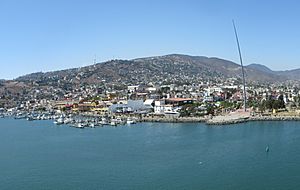
Water sports are a big part of tourism here. Ensenada and its nearby beach towns have great surfing spots. These include San Miguel Beach and Todos Santos Island. Todos Santos Island is a small island west of Ensenada. It is famous worldwide for surfing. Waves there can reach over 60 feet! Many surfing contests, like the Billabong XXL, have been held there.
Tourists also visit Ensenada on their way to windsurfing spots further south. Other sea activities include the Newport to Ensenada International Yacht Race. This is the world's largest international sailing event. It starts in Newport Beach and ends in Ensenada. Whale watching is also popular. Gray whales migrate from Alaska to the lagoons of Baja California Sur every year. You can see whales from Ensenada's coast between December and May.
The nearby town of Guadalupe is known for its olive and wine production. About 90% of Mexico's wine comes from the Guadalupe and Calafia valleys. Many local wineries offer tours and tastings. Every August, the Fiestas de la Vendimia (Wine Harvest Festival) celebrates the start of the wine harvest. This event brings people from all over the world.
There is a street in Ensenada called "La Calle Primera" or Adolfo Lopez Mateos ("1st Street"). It is a popular tourist spot. It has many "Curios" shops (for souvenirs), restaurants, hotels, and clubs. La Primera is always busy with tourists and locals. It is one block from Ventana al Mar ("Window to the Sea"). This is a boardwalk where a huge Mexican flag stands. The Ensenada Carnaval is one of Mexico's biggest festivals. Thousands of people gather in the streets for six days and nights.
Just south of the city is one of the world's largest marine geysers. It is called La Bufadora ("The Blowhole"). La Bufadora attracts many tourists. The street leading to it is full of shops selling Mexican arts and crafts. You can also find seafood restaurants and street vendors selling "churros" and other treats.
Science and Manufacturing
Ensenada is growing in scientific research, especially in marine sciences. It is said to have the most scientists per person in Latin America. The Ensenada Center for Scientific Research and Higher Education (CICESE) does research in Earth Sciences, Oceanography, and more. The Autonomous University of Baja California, Ensenada (UABC) also conducts research. The National Autonomous University of Mexico (UNAM) has a research campus here. It hosts the Institute of Astronomy and the Centre for Nanosciences and Nanotechnology. The National Astronomical Observatory (Mexico) is in the mountains south of the city.
The city has many bio-medical device companies. It is also becoming a center for biotech research. This is helped by its closeness to the larger biotech center in San Diego. Ensenada has six main industrial parks. Its economy focuses more on tourism and technology. Fender guitars and Lowrance fishfinders are made in Ensenada.
Sea Industry
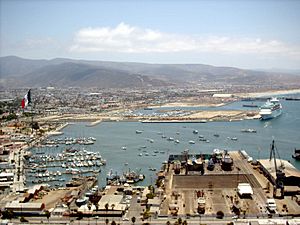
The Port of Ensenada is very important to the city's economy. It is the only deep-water port in Baja California. The port connects Ensenada to cities in Mexico, the United States, Guatemala, Chile, and Japan.
Fishing is also a big part of the economy. More than 90 types of fish are caught here. Important catches include tuna, shrimp, and California spiny lobster. A lot of the fish is sent to East Asia. Ensenada is also known for sports fishing. Many anglers come here each year.
Farming and Mining
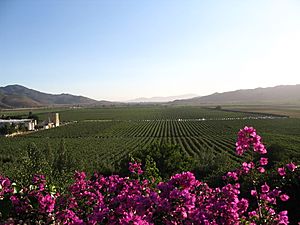
Ensenada has three main farming areas. These are the Guadalupe-Calafia valleys, Ojos Negros valley, and San Quintin valley. The main crops are grapes, olives, tomatoes, and wheat.
Gold and silver mining were some of the first activities in the Ensenada region. Some mines still operate today. In recent years, a lot of gravel has been taken from creek beds. This gravel is sent to California for building projects. However, this has caused some debate. Environmentalists worry that taking too much gravel could harm the environment.
Learning in Ensenada
Ensenada has many places for higher education:
- Autonomous University of Baja California, Ensenada (UABC)
- Center of Nanociences and Nanotecnology National Autonomous University of Mexico (CNyN-UNAM)
- Centro de Enseñanza Técnica y Superior (CETYS), Ensenada
- Institute of Astronomy, National Autonomous University of Mexico (IA-UNAM) IAUNAM-E
- Ensenada Center for Scientific Research and Higher Education (CICESE)
- Institute for Oceanologic Research (IIO) [1]
- Catholic University - Technological Baja California, Ensenada (TBC)
- Technological Institute of Ensenada (ITE)
- Universidad Del Noroccidente de Latinoamerica (UNDL)
- Xochicalco University, Ensenada
- Iuniversi, Ensenada
With UNAM's research center and the CICESE institute, Ensenada has the most scientists and science students per person in all of Latin America. They mainly study astronomy, physics, biology, geology, and oceanography. Because of this, Ensenada is called the City Of Science. Its main institutions focus on marine and agricultural biotechnology, nanoscience, and information technology.
Ensenada's Culture and Fun
Ensenada's culture is a mix of Spanish, Russian, and American influences. Spanish missionaries and Russian settlers helped start the wine industry here. You can even find Russian museums in the city.
The city is known for its fun events and relaxed feeling. It hosts many festivals, like the Wine Harvest Festival (Fiestas de la Vendimia) and Ensenada Carnaval. The Wine Harvest Festival celebrates the grape harvest. Many events take place in the city and the nearby Guadalupe Valley.
A famous food in Ensenada is fish tacos, which started here. You can also find shrimp tacos and ceviche. These dishes often come with avocado and salsa. Another special dish is carpaccio. Ensenada's climate is like the Mediterranean. This allows grapes and olives to grow well. This helps make delicious wine and olive oil. These foods go well with Spanish, Italian, French, and Mexican dishes.
Sports and Excitement
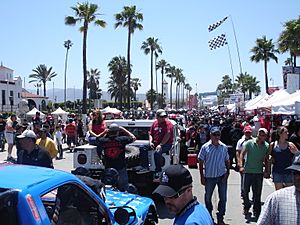
Ensenada does not have professional teams for soccer, basketball, or baseball. But it is famous for its water sports. The city has great places for sports fishing. It also has waves that attract professional surfers.
There is a baseball team called the Marineros de Ensenada. They play in the Liga Norte de México and have won five championships.
Besides water sports, Ensenada is known for biking. This includes both regular cycling and motor racing. The 80-kilometer (50-mile) Rosarito-Ensenada bike race ends in the city. The Baja 500 and Baja 1000 are motor races that start or end in Ensenada.
Ensenada is also the hometown of tennis player Raúl Ramírez and pro cyclist Isaac del Toro.
News and Media
Ensenada has three main newspapers: El Vigía, El Mexicano, and the Gringo Gazette North. They cover local news, sports, and community events. The Gringo Gazette is the main paper in English. Since 2013, La Jornada and El Frontera newspapers are also available. You can also find online news at Ensenada.net, El Septentrión, and Plex.
Getting Around Ensenada
The city is at a key point where major highways meet. These roads lead north to Los Angeles, San Diego, and Mexicali. They also go south to Cabo San Lucas and La Paz. This meeting point is where Federal Highway 1 and Federal Highway 3 cross. Main roads in the city include Bahia de La Paz and Lázaro Cárdenas.
Ports and Marinas
The Port of Ensenada is an international deepwater port. It is the city's main water port. It handles commercial, industrial, and tourist ships.
Besides the port, the coast around Bahia de Todos Santos has many marinas. These include Marina Baja Fiesta and Marina Coral. They offer docking for pleasure boats, fishing boats, and commercial vessels. Many cruise ships stop in Ensenada when traveling between Pacific ports in the U.S.
Airport Access
The city has the Ensenada Airport. This is an official port of entry into Mexico.
Global Connections
Sister Cities
Ensenada has several sister cities. These are cities that have a special friendship with Ensenada.
| City | State | Country |
|---|---|---|
| Oceanside | ||
| Parlier | ||
| Redondo Beach | ||
| Riverside |
See also
 In Spanish: Ensenada (Baja California) para niños
In Spanish: Ensenada (Baja California) para niños


